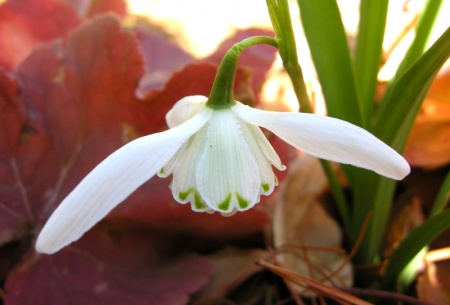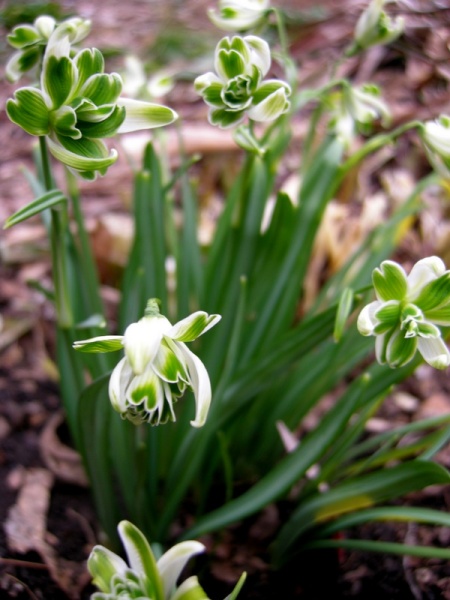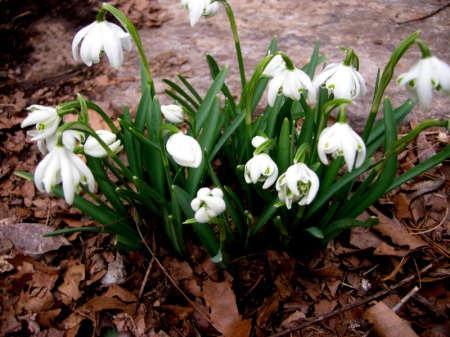Our current snowdrop catalogue is on line here.
 The cover of the February 2016 issue of Fine Gardening
The cover of the February 2016 issue of Fine Gardening
In 2015, I was asked by Fine Gardening magazine to write an article on snowdrops, which appeared as the cover article of the February 2016 issue. For readers who don’t subscribe to this excellent gardening magazine, I am going to reprint the text of the article here, accompanied by images of the magazine layout and some additional photos of the featured snowdrops. Look for my article on spring ephemerals, scheduled for inclusion in the April 2018 issue.
Nursery News: Carolyn’s Shade Gardens is a retail nursery located in Bryn Mawr, PA, specializing in showy, colorful, and unusual plants for shade. The only plants that we ship are snowdrops within the US. For catalogues and announcements of local events, please send your full name, mailing address, and cell number to carolyn@carolynsshadegardens.com and indicate whether you are mail order only. Click here to get to the home page of our website for catalogues and information about our nursery and to subscribe to our blog.
“Passions are born in strange ways, and serendipity often plays a part. In December of 1983, my husband and I purchased our home, not knowing that a treasure trove of snowdrops lay beneath the snowy landscape. Our house was the gardener’s cottage for a large estate, and the gardener who lived there had planted thousands of common snowdrops, (Galanthus nivalis, USDA Hardiness Zones 3-8), which greeted us that February with their delightful honey-scented fragrance. Those snowdrops were to become an important part of my personal and professional life.
For me, the original and greatest appeal of snowdrops is their bloom time. I live on the side of a south-facing hill, where the soil heats up early, and common snowdrops begin to bloom in early February, just when I need some relief from the winter doldrums. I have since planted snowdrop varieties that bloom from October through March, but it is the bursting into bloom of thousands of snowdrops in early February that thrills me the most.
As I gained experience as a gardener, I was exposed to less common varieties and realized that their ornamental characteristics were as interesting as their bloom time was uplifting. Yes, they are small, and you do have to look at individual plants close up; but there are varieties that stand out when viewed from farther away if massed, and many that are worth a closer look. Besides, most snowdrops are easy to grow in deciduous shade and multiply quickly to form striking swathes.
.
 ‘Viridapice’ and ‘Flore Pleno’
‘Viridapice’ and ‘Flore Pleno’
If you don’t currently have snowdrops, then start with the common snowdrop, cultivated in England since the 16th century. The flowers have pure white outer segments (the correct term for a snowdrop petal), and the inner segments have bright green tips. The linear leaves are gray-green, and the plant is only about 4” tall. It is very easy to grow in almost all soil conditions, multiplies rapidly to form satisfying clumps, and is readily available both “in the green” (see sidebar below) and as a dried bulb. With a very small investment of time and money, you can enjoy masses of honey-scented white flowers in late winter.
.
 ‘Blewbury Tart’, ‘Lady Elphinstone’, and a photo showing how I ship my snowdrops.
‘Blewbury Tart’, ‘Lady Elphinstone’, and a photo showing how I ship my snowdrops.
If you are already growing the common snowdrop, you may want to expand your palette to include several other easy-to-grow and easy-to-find cultivars. Of the many cultivars selected from G. nivalis, my favorite is ‘Viridapice’, a vigorous, bold plant with green marks on the outer and inner segments. It multiplies for me almost as fast as the species and, at 5 to 6” tall, has a distinct presence in the garden. The double form of G. nivalis, ‘Flore Pleno’, is also lovely, if a bit disheveled. It is the earliest recorded snowdrop cultivar, with references to its existence in the early 1700s.
.
 Galanthus elwesii, ‘Magnet’, and a photo showing how I divide snowdrops.
Galanthus elwesii, ‘Magnet’, and a photo showing how I divide snowdrops.
For an even more distinctive look, plant G. nivalis ‘Blewbury Tart’ or ‘Lady Elphinstone’, both double-flowered, vigorous growers. ‘Blewbury Tart’ points its mostly green, frilly, double segments upward and definitely stands out in a crowd. It was discovered in a churchyard in Blewbury, England, in 1975 by snowdrop expert Alan Street. Although a prominent British journalist told him it looked like a squashed fly on a windscreen, Alan introduced it, and it has become a favorite here and abroad. ‘Lady Elphinstone’ is another venerable snowdrop, dating from 1890, and is one of a kind: its inner segments are a lovely egg yolk yellow. Sometimes the yellow takes a year or so to settle in, but it is worth the wait.
.
.
There are 19 species of snowdrops in addition to G.nivalis, and many of them have produced cultivars and hybrids, resulting in over 1,000 named varieties. Most are not available in the US due to treaty restrictions; however, a diligent search yields a nice collection. Here are five more I recommend for beauty and vigor.
.
 Galanthus elwesii, the giant snowdrop
Galanthus elwesii, the giant snowdrop
Not only is the giant snowdrop (G. elwesii, Zones 3–9) larger than the common snowdrop, but also it blooms earlier, starting in midwinter. This species tolerates hotter and drier conditions, making it great for Southern gardens. Its broad, upright, blue-gray leaves surround large, well-formed flowers with two bold green marks on the inner segments. Lots of natural variation in this species produces powder blue leaves, a variety of marks, and bloom times anywhere from November to February.
.
‘Diggory’ (G. plicatus ‘Diggory’) is a cultivar whose heavily quilted, pear-shaped, squared-off flowers make it recognizable anywhere. The wide, elegantly pleated leaves are characteristic of G. plicatus. Found in 1993, ‘Diggory’ became an instant, much-sought-after classic.
.
A hybrid snowdrop with dignified double flowers, ‘Lady Beatrix Stanley’ (G. ‘Lady Beatrix Stanley’) features a tightly packed inner rosette edged in green and a distinctive mark split into two elegant dots. It is easy to grow and multiplies well.
.
‘Magnet’ (G. ‘Magnet’) was selected in the 1880s and is still loved by collectors for its classic beauty and vigorous growth. It is instantly identifiable by its long flower stalk that allows the large blooms to sway in the slightest breeze.
.
‘Wendy’s Gold’ (G. plicatus ‘Wendy’s Gold’) offers beautiful, large yellow markings on the inner segments and the ovary (the little cap above the segments), and wide, elegantly pleated leaves. It is much sought after for its beauty and vigorous growth. Other nice yellows available in the U.S. include ‘Primrose Warburg’ and ‘Spindlestone Surprise’.”
Carolyn
.
Note: Every word that appears in orange on my blog is a link that you can click for more information. If you want to return to my blog’s homepage to access the sidebar information (catalogues, previous articles, etc.) or to subscribe to my blog, just click here.

































































